You’re Gonna Need a Bigger Lift Bag…., Possibly a Bigger Boat…. July 1, 2020
- SCDC

- Jul 11, 2020
- 4 min read
Author: Simon C

Photo credit (above): Cath C
Dropping a 50kg block into the water and moving it on the bottom was going to require a bit more discipline and organisation than the usual splashing off the boat on a fun dive.
… as the discussion went on a Thursday night social, whilst planning how to sink a 50kg concrete weight on an upcoming small boat dive. Starting at the beginning, with the July 1st public holiday upon us, it was a good time for the club to deliver on a project that had been a few months in the making. It all started with a fascinating talk by Dr Lindsay Porter, from the University of St Andrews, about her work studying marine mammals around HK (click for more info), including acoustic monitoring underwater. Following the talk, we discussed sites the club regularly dives in the north east of HK and decided to help deploy a monitor at one of these sites.
Photo credit (above): Simon C
In order to secure the recorder in place on the sea bed, the first thing needed was a suitably sturdy “anchor” to attach it to. Alex G thankfully volunteered his DIY skills and got busy making a very nice 50kg concrete base with anchor points and man-handled it to Sam Mun Tsai. As the team arrived and the heavens opened, we took shelter and all took a turn at seeing how heavy the concrete was. As the rain passed, tanks, gear and the concrete base were loaded on to boats and we headed to the fish farm platform to kit up.
Alex G and Cath C gave a detailed brief on the dive plan and team responsibilities. Dropping a 50kg block into the water and moving it on the bottom was going to require a bit more discipline and organisation than the usual splashing off the boat on a fun dive.
All briefed, we headed out of Tolo harbour destined for one of the remote reefs in the north east. Quickly on-site, the objective for the first dive was to locate a suitably flat area, with a wide exposure to the surrounding seas, to place the recorder. Jumping in, it was clear the water temperatures were still in the “fresh” category.
Dropping down, the visibility was good, but there was a pronounced thermocline around 6m and it got decidedly cooler below that. Scouting the edge of the reef and the drop off, a suitable flat location was found pretty quickly and marked with a tied-off DSMB. With that job done, there was time to head back up to the warmer water and enjoy the good visibility.
Photo credit (above): Simon C
Shallower, there was quite a lot of surge causing divers and even some fish to swing back and forth 1-2m with it. There were a lot of smaller bait fish moving rather quickly around the reef. We saw a nice nudibranch and a big octopus in the rock, both of which provided a risky challenge to photograph in the surge, with a dome lens on the camera.
During the surface interval, over sandwiches, the location of possible sites marked was discussed, although with one DSMB floating off, that was that site off the list. Having decided on the location to use, it was time for the main event and dropping the concrete base.
The camera team floated with anticipation, ready to capture the moment and with surprising ease, the concrete base was dropped over the side. As it was lowered, it looked to be heading straight down the line marking the site. As deployment team then headed down the line, the weight was actually a little way from the proposed site and on a slope. With the help of a lift bag and some man-handling, the weight was moved and located on a flat shelf at the chosen location. The recorder was then fixed to the holding bar and the job was largely completed. Two teams tied of lines and set off to lay markers, to ease the job of relocating the device in a few months time.
With the main task of the day behind my buddy and I, there was still half a tank left to explore the reef. We decided to head out on opposite side to the first dive, following one of the lines laid, trying to stay in the warmer shallower water. There was still a lot of surge and a lot of bait fish, but nothing remarkable. Heading back along the line we managed to get a better picture of the recording device in situ, with much reduced silt, and then time to go up. On surfacing, teams that went in the opposite direction were excitedly reporting a group of big barracuda, although no one had a camera to get a snap.
Back on the boats it was time to pack up and head back in very good time. With everything unloaded, there was time for some spicy fish balls and a couple of glasses of beer to celebrate the days successes.

Photo credit (above): Cath C
All-in-all, another good day out and hopefully some useful data will be captured. Credits to Alex G for planning and manual labour, Cath C for organising the boats and Naomi B from the research project supporting us
For more information on the marine mammal research work being done in Hong Kong please see the following this link.






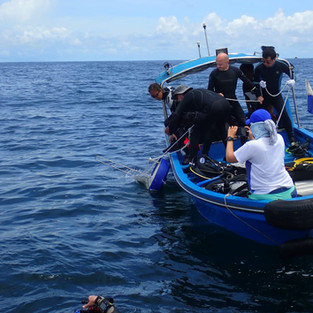





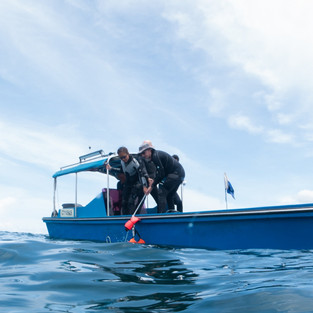



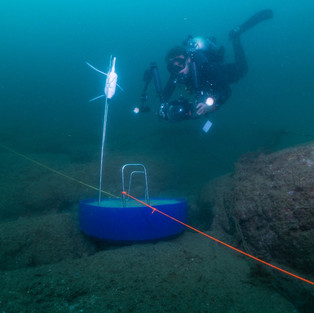









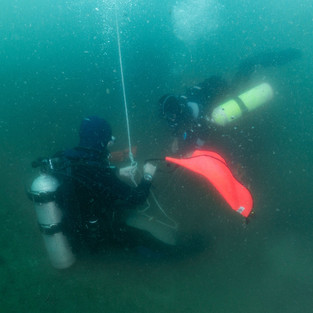



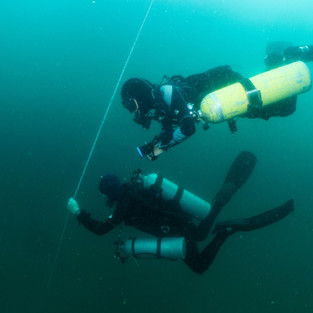



Comments